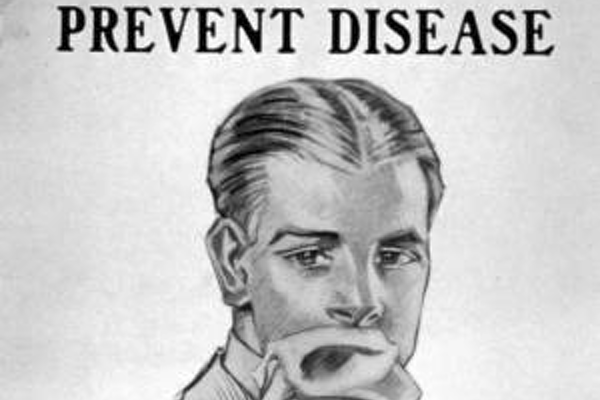The Local Impact of the 1918 Influenza Epidemic in Philadelphia
The Deaths Began
The first reported death in Philadelphia during the 1918 pandemic occurred at the Naval Yard on September 11,1918, and the number of stricken military personnel quickly grew. Insufficient attention was paid. The United States was in the throes of the Great War, and the Kaiser, not the flu, was on the minds of Philadelphians. Some saw the flu as a German plot. By September 23rd there were 600 cases of influenza among the city’s military personnel and by the 28th there were over 500 cases among the city’s civilian population. During that same week, 149 civilians succumbed. Later, on a single day in October 1918, there were 759 flu deaths in Philadelphia. Ultimately 12,687 died of influenza or the pneumonia that accompanied it.
U.S. Surgeon General Rupert Blue warned that “influenza is a crowd disease,” and if possible, that large crowds should be avoided. Despite the message from federal public health officials, Philadelphia proceeded to hold a Liberty Loan Parade on September 28th. It attracted some 200,000 viewers. The Public Ledger praised the procession as “the greatest the city had ever seen.” The following week physicians, and nurses reported 4,541 new cases of influenza, nearly nine times the number reported for the week prior to the parade.
This flu was different from others. It was especially brutal. Earlier outbreaks took the old, the sick, and the young. This one ruthlessly killed healthy Philadelphians in their prime: 20-40 year olds. Countless families lost their main source of household income, as the flu claimed thousands of young workers. Wives became widows, husbands' widowers, and children orphans.
Closing Down and Stepping Up
The Philadelphia Department of Public Health and Charities issued an ordinance closing schools, churches, theaters, moving picture houses, places of amusement, and public assemblies. The authorities advised people not employed by businesses unaffected by the ordinance to refrain from going to work if suffering from influenza or related complications. The closings angered many citizens who did not understand the risks of public gatherings or who resented and suffered from the economic hardships these orders imposed.
Voluntary organizations provided some assistance. The Automobile Club of Philadelphia and the Autocar Company of Philadelphia supplemented ambulance services and transported physicians and nurses on house calls. Taxis gave rides to visiting nurses. The Patrolmen’s Benevolent Association provided off-duty policemen to work as stretcher-bearers. Firemen delivered medical assistance and food, and hundreds of teachers stepped up to volunteer. The city established a hotline; often those calling only required information or encouragement. The Child Welfare Federation (CWF) coordinated some of the city’s efforts. It designed a map dividing the city into districts, pinpointing various social agencies, and indexing the rough notes of executives, nurses and others. The CWF made the fight against influenza easier for those on the phones dispatching medical personnel or attempting to provide information to the sick.
With 1,000 physicians and 900 nurses absent on military duty, juniors and seniors from the city's medical colleges (which closed during the epidemic) attended patients. Ten temporary hospitals opened to provide relief, including some in clubs and churches.
The Philadelphia Board of Health posted signs to educate the public. One warned, "To prevent the spread of Epidemic Influenza sneeze, cough or expectorate (if you must) in your handkerchief. You are in no danger if everyone heeds this warning." The city's trolley cars and lampposts had signs with a shorter reminder: "Spit spreads death." Despite these warnings, twenty-five people were arrested for spitting.
On the Front Lines
Philadelphia established ten special hospitals to care for the growing number of victims. Volunteers, workers, physicians, and nurses from the city's Division of Child Hygiene, provided care along with nursing and medical students brought in to assist the expanding numbers of very sick patients. The frantic organizing did not always go off without a hitch. The city sent nurses and doctors to visit the homes of sick Philadelphians and, at times, five or six would visit the same city block to see patients, while never visiting influenza sufferers just one block away. The role of nurses during the epidemic was much greater than that of doctors. Lacking an effective treatment to combat influenza, patients relied on the care and devotion of nurses to pull them through their illnesses.
Caring for the Dead
The city's single morgue, with a capacity to store thirty-six bodies, could not accommodate all the corpses that kept arriving. They had to be stacked three or four deep in the basement. Some professional embalmers refused to work on the decomposing corpses. To rid the building of the stench, the doors were left open, creating a sideshow for all who walked by. The city soon erected five new temporary morgues. Some relief came from the federal government. Secretary of War Newton D. Baker sent embalmers to Philadelphia at the request of Mayor Thomas B. Smith. The Council of National Defense then organized several companies with woodworking equipment and contracted with them to build coffins for burying Philadelphians. No more than 20 percent could be added to the coffin prices to cover carrying charges and profit. Demand exceeded supply and the situation became so desperate that one funeral home had to hire a security guard to protect the coffins. Volunteer gravediggers did their part as the city struggled with the growing numbers of bodies.
Relief
Almost as sudden as its onset, the influenza, which had taken over Philadelphia just weeks before, began to wane. By October 25, the numbers of new cases were falling. With just over 100 new cases for the entire first week of November, the epidemic was over. As the fear of infection subsided, Philadelphians were permitted to try to resume life as they knew it prior to the outbreak. Thousands of survivors no doubt wondered how they would find the strength to pick up the pieces and continue.
